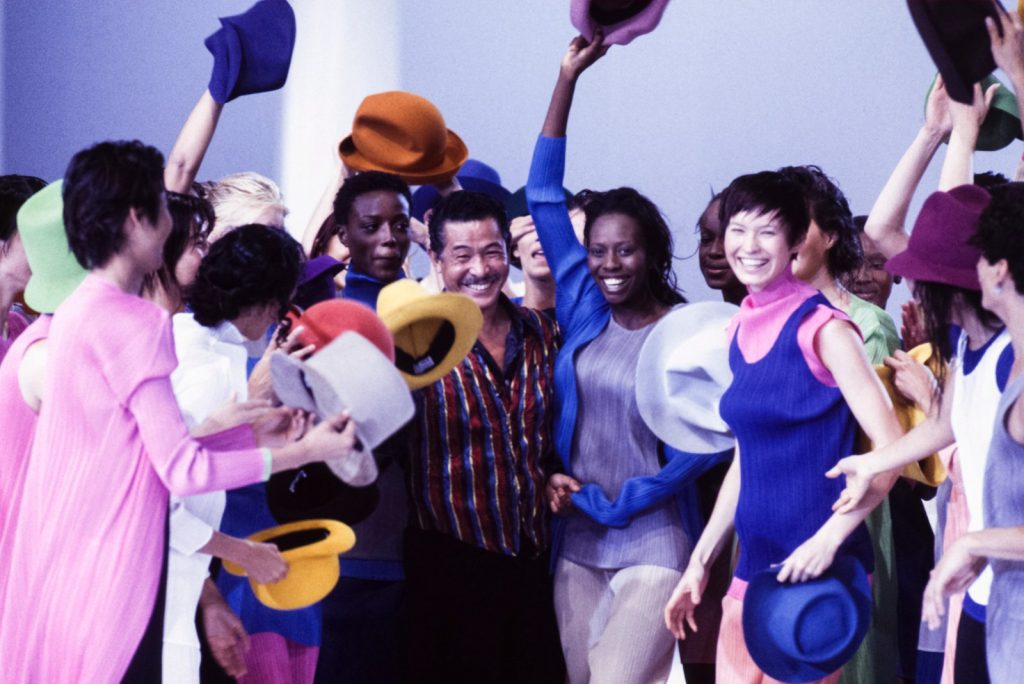
Issey Miyake’s Menswear Revolution Was Pleated
Sargent soon found himself wearing them to dinners and parties. To Miyake, user friendliness never came at the cost of elegance, making Homme Plissé is one of the only brands that you can wear in coach and also to a Met Gala afterparty. “They’re not sweatpants, right?” says Sargent. The material is structured yet soft, with a pleasant sheen that can read as formal or not, depending on the light. And the imaginative silhouettes that look demure one moment seem to come alive when the wearer moves—or better yet, dances.
To Miyake devotees, the designer’s pleated garments approach an almost universal system of dressing. “In a way, Pleats Please has a democratic sort of spirit to it, in that nobody looks bad in it,” says Sargent. In Pleats Please, “You can look thoughtful and you can look intelligent and you can look elegant. And not many clothes that you can throw on in five minutes can do that.”
A-Cold-Wall designer Samuel Ross has noticed men around London catching on in recent years, too. “I feel partly responsible for that,” admits Ross, who started wearing Homme Plissé almost daily after his wife introduced him to the brand. He describes feeling the pleated fabric for the first time as a revelation. “In a way, it didn’t feel informal—it felt quite tactile but elegant, and sensual at the same time,” says Ross, who has built up a collection of around two dozen pleated garments. “I remember being shocked by the sheer feeling alone,” he says, “and I remember thinking: ‘This is the work of an industrial designer, this is the work of an artist. I was captivated immediately.”
Miyake was a populist, and he rejected the label fashion designer, insisting instead that he was just “making things.” He wanted his work to stretch well beyond the insular and elitist fashion world he had first encountered in Paris. To Ross, Plissé is the fulfillment of this promise. “When you buy a Plissé piece, you feel like you’re buying a piece of design,” he says. In London, at least, Ross sees Plissé as a symbol of equality. “We’ve always imposed a formal trouser,” he says. “Issey Miyake Homme Plissé has come along and situated itself in between the class situation in the country, and enables men’s mobility up and down. I think that’s really special and it solves a problem socially here.”
The day Miyake’s death was announced by his studio, tributes posted on social media illustrated just how many people actually wore and engaged with his work. For every post of Robin Williams in an Issey Miyake bomber, Steve Jobs in his famous custom turtleneck, or Joni Mitchell in her lavish pleated shawls, was a personal testimony, like one from the journalist Joe Bernstein: “I have a pair of hunter green Pleats Please slacks that my Swiss mother-in-law mocks me ruthlessly for owning, but I’ll be wearing them today in honor of Issey.” How many people wore Chanel the day Karl Lagerfeld died? At least three Condé Nast colleagues were wearing Homme Plissé in the office yesterday, and I spotted a few more fans on my walk home.
Even before his death was announced, it was clear that Miyake’s pleats were having a moment. Two days prior, Sargent happened to visit the Issey Miyake flagship in Tribeca to re-up on a few staples. The store, he says, was packed.